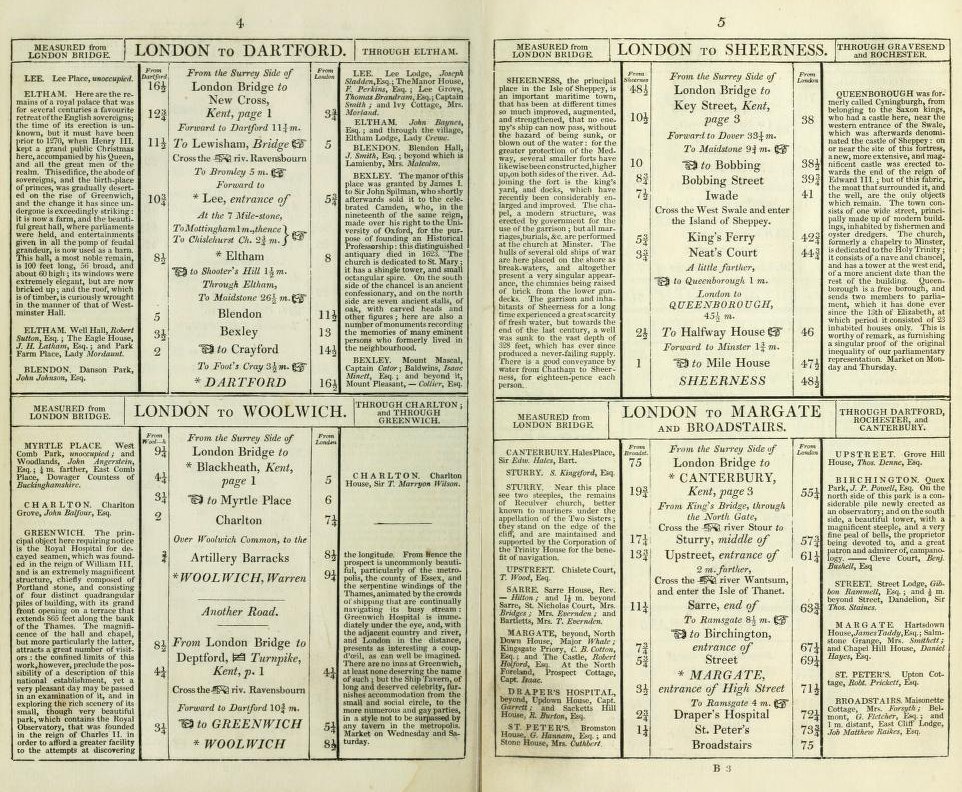
Paterson’s Roads (1826 edition)
It is an attempt, as far as the nature of the work will allow, to Map the ground…
So declares Edward Mogg in the Preface to the final edition of Paterson’s Roads, possibly the closest thing the nineteenth century ever got to Sat Nav. The book — which ran to eighteen editions from 1771 to 1829 — is designed to guide the journeyer along the major roads of England and Wales, helping them not only to get from A to B but to appreciate the landmarks along the way. Perhaps the most extraordinary thing about the book is how very few maps it contains, giving a far from complete coverage of England and Wales. The vast majority of its huge amount of information is textual, and the book starts as it means to go on, with a densely informative index of roads and towns.
 Scroll through the whole page to download all images before printing.
Scroll through the whole page to download all images before printing.In these two and half lines above we learn that: the Yorkshire town of Abberford has a market on Mondays; the Direct Road route to it from London is described on page 228; the town is also mentioned among the Cross Roads on page 447; post-horses can be found at the Swann Inn; and London is 186 miles away.
The second part of the book describes, in 346 tall pages, the Direct Roads from London to the market and sea-port towns of England and Wales, embellished by accounts of tourist attractions small and great: “STONE HENGE. The true origin of this stupendous structure yet remains a matter of doubt... Seventeen huge stones are now standing... the appearance of the whole is singularly awful and surprising.” The third part of the book, also clocking in at over 300 pages, describes the Cross Roads which link together the towns up and down the country. Browsing its pages, which resemble a cross between Lonely Planet England, 100 Greatest Walks in Britain, and AZ Great Britain (without the maps!) you get the feeling of reading a book for someone who is hyperlexic but image-phobic, written by a caring friend.
There then follows another impressive index of the “country seats, places, prospects, antiquities, and remarkable objects," of the nation, referring readers to appropriate pages in the roads sections of the book. And finally there is a wonderful appendix, chock full of further informational delights, such as a town-by-town population table based on the 1821 census, and “the Heights of all the principal Hils and other remarkable Eminences in England and Wales”. If you dig deep enough, you can even discover when the Post Office packet boats leave Falmouth for Lisbon (every Friday).
On their travels the book encourages readers to cross bridges, spin turnstiles and traverse junctions, all whilst also navigating its 700 plus pages. The Advertisement suggests that it will be “convenient in the carriage of the pleasure tourist.” Bring to mind Google Street View on an iPhone, and you’ll never have a stronger sense of the relative nature of convenience.
As mentioned already, the book ran to eighteen editions, the first published in 1771 by British Army office Daniel Paterson and titled A New and Accurate Description of all the Direct and Principal Cross Roads (the fourth edition from 1778 is the earliest we could find on Internet Archive). When Edward Mogg edited the sixteenth edition in 1822 he thought the original author was dead. By 1826, when Mogg edited and published the final edition of this titanic book of roads, Daniel Paterson had indeed expired.
 Scroll through the whole page to download all images before printing.
Scroll through the whole page to download all images before printing.Jan 16, 2019









